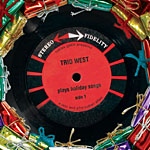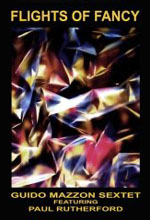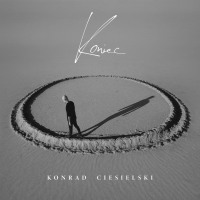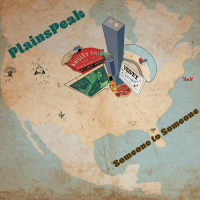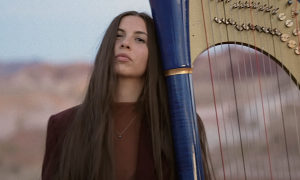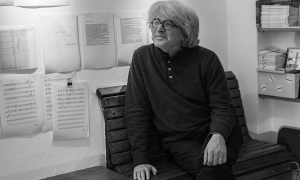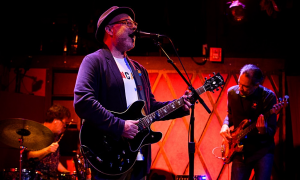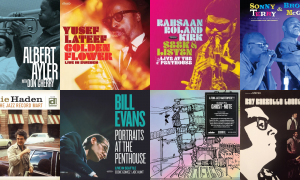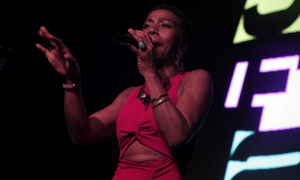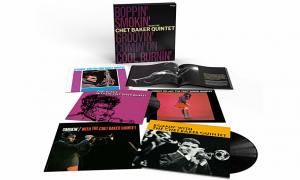Home » Jazz Articles » Interview » Eberhard Weber: Please Don't Play Jazz
Eberhard Weber: Please Don't Play Jazz
Weber made his name in Europe performing with pianist Wolfgang Dauner in the late 1960s and early 1970s, and the music the two musicians played during their affiliation covered a rather considerable territory—straight-ahead jazz, yes, but also free and jazz-rock forms.
Weber's 1974 debut, The Colours of Chloë, remains a near-perfect album and presented an artist whose creative vision seemed completely mature; the rich tonal colors and symphonic sweep of the compositions—not to mention that sound of his bass—remain innate characteristics of his music. This recording marked the beginning of Weber's association as a leader with the ECM label, a relationship that continues to this day; he remains one of the quintessential ECM artists. Weber's appearances on such classic ECM records as vibes master Gary Burton's 1974 album Ring, guitarist Ralph Towner's 1975 Solstice, guitarist Pat Metheny's 1977 Watercolors, as well as his remarkable recordings with his own band Colours (Yellow Fields, 1976; Silent Feet, 1978; and Little Movements, 1980) established him as one of the greatest and most popular players of the 1970s and 1980s.
Weber has maintained a working relationship with British pop artist Kate Bush, having played on several of her recordings. His greatest collaboration, of course, has to be with saxophonist/composer and ECM labelmate Jan Garbarek. Weber's played on multiple Garbarek recordings and has worked as a permanent member of Garbarek's band for many years.
Weber has kept a lower profile over the 1990s and into this decade, but his new ECM recording, Stages of a Long Journey—a live document of two nights in Stuttgart, Germany celebrating his 65th birthday, and only his third release since 1990—is as enjoyable and musically vital as any of his records. It consists of, essentially, some of his most famous compositions—his greatest hits, as it were—performed with some of his storied jazz colleagues and a symphony orchestra. But the music is considerably more vital than that synopsis and feels like a perfect introduction to his music for a novice. I spoke with the always-opinionated Weber about the project and a great deal more.
Stages of a Long Journey and Working With an Orchestra
All About Jazz: The primary purpose of this interview is to discuss your very fine new ECM recording, Stages of a Long Journey, which documents the fantastic music performed at your 65th birthday celebration in Stuttgart in March of 2005.You're were joined for this performance by, essentially, the Jan Garbarek Group plus Gary Burton, Wolfgang Dauner, Reto Weber and Nino G. plus the SWR Radio Symphony Orchestra Stuttgart. It's a great program of mostly your compositions. I think this would make a great introduction to your music for a newcomer, but there is plenty to fascinate an old fan as well. The concert is wonderfully paced and adds some new colors to the compositions, and while there is an orchestra—conducted by Roland Kluttig—it feels no more or less orchestral than your music always does, being always so thoughtfully arranged to bring out voices and timbres. Tell me the origin of this event—how it began and what, if anything, you wanted the concert to be or to emphasize.
Eberhart Weber: Well, it's a life story, almost. You might know that I was very much raised in a classical family. My father was a music teacher, and so I was raised with fairly good music. So I always had this approach to different music, particularly to orchestral music, symphonic music, and so on. So when I finally decided in the sixties or seventies to switch to bass, because I was interested in jazz—I played cello first—I followed the regular routes, like all jazz musicians did. You get your bass, drums, piano, guitar, trombone or whatever, and you play the tune, you play your solos, and you play your tune again. And that's it! That's how jazz has worked for decades.
And it hasn't drastically changed at all. When you listen to young jazz guys, they still play the same stuff. They're very good, but it's still the same procedure. So at some point, once I had started to write and compose in the seventies and eighties, I thought about this kind of simplicity—or even stupidity—of the jazzy procedure. It sounds a little bit awful now, but I thought, "Why not look for other things? I listened inside myself and knew I wanted to compose in jazz differently.
With my band Colours, my compositions were already different. I had an introduction, maybe scene number one, and then only 16 bars of improvisation, then an interlude, scene number two—it was done much more like classical composition. It started more or less with The Colours of Chloë, my first album—which, astonishingly, the Americans liked. They said, "It is kind of jazz, but it's not American—what the hell is this?
I was proud I'd found something that worked as well as it did, and I pretty much continued in this way, to approach the audience and the music in a different way than the regular "good-old-jazz way. And after decades, it became only logical that my dream to really work with a symphony orchestra became stronger and stronger. Of course, nowadays you have to acknowledge the fact that working with a symphony orchestra is a very, very expensive objective. What can you do? You're not a pop star where it doesn't matter how much time you spend in a studio. I was always annoyed by pop and rock people where they'd put out an album and in the liner notes they'd write, "We worked every day in the studio for two years. This is simply stupidity! They're unable to produce anything in a few days; they need years in the studio! Do you know how much a studio costs per day? So some lousy production costs I don't know how many millions.
AAJ: Yes, they spent the first year just getting a good snare drum sound.
EW: Yes, exactly! So I didn't have these financial possibilities. So when I approached ECM at some point to do my last album before this one, Endless Days, the idea was to find a symphony orchestra. ECM had connections at the time with [Estonian composer] Arvo Pärt and such people, and there was thought of using some Eastern European symphony orchestra—they're still a lot cheaper than the ones in the west. Certainly, you could never pay the very famous orchestras; it's impossible. But we figured out that for the numbers of records I sell, it's not feasible to hire a really big symphony orchestra. So I made that album with samplers, and I was kind of satisfied, although it wasn't the real thing. It wasn't a real symphony orchestra, but for me it was real. Usually when you tell someone something was done with a synthesizer, they get negative, but using synthesizers doesn't have to mean having synthesizer sounds. If they're sampled sounds, they're real sounds, and it sounds like a real orchestra.
Anyway, that album was released and got good reviews. A few years later, I worked with a promoter who does some music festivals, usually in the winter, about 100 kilometers from Stuttgart. I had done things with him as a solo player here and there over several years, and we became friends. So just one year before my 65th birthday, I did a concert with him, and that's when he told me that he knew members of the Radio Symphony Orchestra in Stuttgart and he wanted me to do a project with them. I said, "Hey, what a nice idea. Do you think you could get the whole orchestra enthusiastic about doing something?
So he approached the orchestra, and they were interested, because their regular job is to pretty much play the classical stuff—the Mozart and Beethoven and Brahms. Then when it comes to playing modern stuff, they have to play this contemporary music which [laughing] nobody really likes, all this twelve-tone music and so on, the things that get played once and never again. So these kinds of orchestras like to find other playgrounds. They know they have to find new markets and new audiences. So they thought it might be interesting to work with some jazz musicians.
So the orchestra agreed. I did agree to their wish that they also play some classical pieces, which I wanted as well. So during these two birthday concerts, they also played a Stravinsky piece, a Charles Ives piece, a Ravel piece. And this was music that might have been new for some members of the jazz audience. Anyway, the audience loved every second of what this orchestra played. They loved it all. So they were glad they did it, and I was really proud, because after we'd done the first night's concert, the spokesman of the orchestra came over to me and said, "We liked every second, and I have been asked to tell you that we can't wait to play tomorrow.
Stages of a Long Journey: Who Else to Invite?
So anyway, once the orchestra had agreed to do the concerts with me, I thought, "Who else should I invite? There needed to be some jazz musicians. As you know, I've played and worked with lots of jazz musicians throughout my life and career. But again, there were financial limitations. When you play a hall that holds 900 to 1000 people, you can only pay each musician so much. And if I'd invited ten or twenty players, there would also have been problems with time—it gets out of hand either way.So I ended up inviting just a few people that had been very important for my musical development throughout my career—a career that actually started with a German pianist, Wolfgang Dauner. I was still an amateur when he picked me, and it was over the two or three years with him that I became more or less known in Germany, and somewhat elsewhere in Europe.
AAJ: Right, in that trio with Fred Braceful on drums.
EW: Exactly, yes. So Wolfgang Dauner was the first one to make me a little bit known. And after I did my first album, The Colours of Chloë, and it was released in the States, [vibes player] Gary Burton discovered me and decided to work with me. So then I did two albums and a lot of tours with him in the United States as a guest bassist—not as his bassist, but as a guest soloist. So he was also very important to starting my international career.
And, then, of course, I've worked permanently in the last 25 years with [saxophonist/composer] Jan Garbarek as a member of his group. We're really wonderfully linked together; we have an ideal musical sensitivity together, and I knew he had to be there too. He agreed. The other pianist for the concerts was the German player Rainer Brüninghaus. He worked in my band Colours and in other situations with me. And after I asked him, it was only logical to ask the drummer Marilyn Mazur—then there's the whole Garbarek band.
In the last five years, I've done some occasional work in the Switzerland schools—workshops and so on—together with this Swiss percussion player, Reto Weber. He has lots of contacts with other people including Nino G., this human beatbox. So Nino G. was part of the concert, and I did not announce that—it was not on the poster. I kept it secret from everybody, from the orchestra—no one knew he'd be part of the concert. He was a surprise act and did just ten minutes of this kind of fantastic stuff. And the audience and orchestra freaked; they'd never heard anything like that.
So these two nights were just a wonderful experience for everybody, and the audience really liked it. I even had to cut some of the applause on the album, or it would have been far too long. I wanted it to be just one CD. I also didn't include the classical pieces, because it doesn't make sense that there's suddenly a Stravinsky piece on my album. It didn't make sense. So we just presented the jazzy side of the concerts.
AAJ: I was particular struck by how magnificent Gary Burton is throughout the record. His vibraphone sounds so fine with the particular arrangements of the brass and strings of the orchestra.
EW: Well, that is lovely to hear. I mean, apart from the fact that I wanted to have him because of what he did for my musical career, I also admired him as a fabulous musician. For me, he's the world champion of the vibraharp. And that's also why I picked the Carla Bley piece ["Syndrome ]—because I heard it on one of his ECM albums, and I knew it would be the perfect piece to present him. And as you can hear from the applause, the audience went nuts—they couldn't believe what he played.
Using Older Material and Why Conductors Must Be Dictators
AAJ: Were you at all intimidated or sobered by the notion of the way such an event sort of lays out your career? It gives it such a retrospective quality.EW: Not really, no. I'm selfish enough to believe that I can survive events like that [laughing]. Of course, it was nerve-racking once everyone had agreed to do the concerts. "Oh God, what have I done? The idea of having this 80-piece orchestra and some of the most famous jazz musicians in the world together—and then having to present something that actually works together. Usually classical music and jazz, in my opinion, don't really work together. There have been so many attempts in the past which have failed, really, because they do some kind of a contemporary classical intro, then there is some kind of free jazz, and then the symphony orchestra comes in here and there—it never really works. These two types of music do not work together.
Do not forget that classical musicians can't improvise. They don't know how to deal with that, and they don't really understand how we manage to improvise—to play with somebody without even knowing this person, without ever having worked with him.
And, of course, I have been asked why I did not compose anything new—why did I use older tunes? I wasn't really a coward, I would say, but I thought that some of these pieces were released in the seventies and eighties. They've been released, presented, played, and some people bought the records—and that's it. These tunes are gone. Now, thirty or forty years later, they are not played anymore. I thought, "What a waste!
I talked to Garbarek and he does the same thing: He opens up his drawer and takes out some lead sheets from thirty years ago and says, "Ah, this is nice. It was nice then—if it's still nice today, why not play it today? So I felt the same way and decided the concert should be my most famous compositions, starting with "The Colours of Chloë, "Yellow Fields, and so on.
Then the challenge was what I was going to do with a big orchestra. I had hardly ever composed or arranged for symphony orchestra. But I sat down for months and months, thinking about what to do, and working, and slowly I became satisfied with the results. Then, of course, when I reached the point that I had to present the music to the orchestra, it was nerve-wracking for me. "What will they say? But they just said, "It's nice. I was lucky. And I didn't want to keep the original shape; I wanted to add a few pieces, interludes here and there, to really take advantage of the fact that there is a symphony orchestra.
I did try to avoid the typical background string stuff. I think the orchestra was afraid that I would just use them for background sound, and I tried to avoid that. I didn't want to use them as background, and I didn't want to use them to sort of insert typical classical stuff. I wanted them for solid sound embedded into my kind of musical thinking.
And I think it worked. I haven't read that many reviews so far, but the ones I've read were all good. No negative stuff so far.
AAJ: You put it perfectly. You managed to imbed the orchestrations into the material. The instruments of the orchestra are just other voices that have the same importance and function as all the other voices. It's organic.
EW: Yeah. But I have to admit that a lot of it is subconscious. I didn't really think about that at all. I just knew what to avoid, and whatever was left—that's what I used.
AAJ: Sometimes just avoiding what you know is bad is an effective strategy. Was anything attempted that didn't work out? Did you have any material that you didn't use?
EW: Yes. There was one piece for Rainer Brüninghaus and the orchestra, but the only place to play it was after the duet I did with Wolfgang Dauner. This would have been too close—it would have been a comparison of two piano players. I thought, that would be stupid—there was no competition going on here. Besides, it was another twelve minutes to the concert. It was just too much. The concert itself was already approaching four hours. I had to cut it down, keep people interested.
But there are thoughts of repeating this project—maybe with different orchestras—next year or in 2009. There are many orchestras I didn't know about in Europe that are thinking about doing other stuff than their regular concerts. Lots of these orchestras have shown interest. So we are negotiating.
AAJ: How much rehearsal was there before the concerts?
EW: We had, I think, two three-hour rehearsals with the orchestra; that was in the morning. In the afternoon, we did some things with the other musicians. We basically just ran stuff through, and none of it was a problem. We just had to be together; we had to decide during the rehearsals how many choruses we'd do of something, when the orchestra would come in and out—just those organizational things. Otherwise, musically, it was never a problem. All the jazz people were so experienced and so wonderfully trained that everything was good, smooth. And, of course, the classical people can read anything at any moment. Once we realized that they accept us jazz people and admire us to a certain extent, then we knew we'd made it.
Because, you know, classical people can be awful. It's very restrictive. And that's the reason that conductors have to be really nasty! If you're too nice [laughing], you're lost. You have to be a dictator.
AAJ: They don't respect vacillation or weakness.
EW: No. If you make one mistake, you're lost. That's why all the famous conductors have been dictators. They need to be.
No Deep Thoughts and the Most Beautiful Ballads Ever Written
AAJ: Let's talk about some individual songs on the CD. "Silent Feet is a song that first appeared on the 1977 album of the same name. That version begins with your bass and Rainer's piano. Here, the piece begins with that soft, harmonized orchestral sigh—sort of a gorgeous hum before Marilyn's percussion and those orchestrated rhythmic figures come in. I think the ensemble melodies of this song work very well for orchestra, and there's typically still plenty of space in the music. Tell me about this song.EW: Well, I do have to disappoint you, because whatever I did, I did more or less automatically. I sat down, listened to the old album, and thought, "Ah, I don't like this introduction anymore. I have to do something new. What else can I do? So I thought I would just start with the orchestra. I tried a few things, and either liked or disliked what I did until I had something I thought was nice.
But there were no deep thoughts. There was nothing like, "I have to do this, I have to do that. I just say I love music, I composed it, and after having my doubts, at some point I liked what I did. And hopefully, you like it too. I don't have any comments like, "Music is an island of beauty. I don't care about that.
AAJ: I think it's rather brilliant that "Seven Movements, which first appeared on your 1989 Orchestra recording, has been effectively de-orchestrated here. It's now a duet between you and Garbarek on soprano.
EW: Yeah. This is a piece which I kept in my solo program. Whenever I did solo performances on my bass, I would play this piece. Later on, I had some offers to do some duet things with Jan, so we played some concerts in Norway and Germany. So when I thought of which piece might be nice, I thought this might be good with him.
As a matter of fact, this piece was never rehearsed. I just played it for him, and he has good ears. Whatever he played was not written; he just improvised. Before we performed it, I said, "I have this part, and played him the part, and this part, and played that, and so on. "Then we do the second part, and the first, and he said, "Okay, fine, and wrote it down, and then we played it. And this was it. And it's good to have it fresh; you can't over-rehearse it.
You know, I also did this for Endless Days, as I said in the liner notes to that record, but I said to the guys, "You're allowed to play anything—but please, don't play jazz. Just follow what you hear, and try to improvise in that matter without imitating. But please, no typical jazz stuff. I feel like when I have the opportunity to present my own album, my music—which becomes rarer and rarer because there are so many musicians, and ECM can't produce more than so many albums per year—it should be my music, and not somebody else's music. I don't want to start with a piano solo where the guy plays for ten minutes. That's not what I want. He should do his ten-minute introduction on his own album.
So I'll say, "I need a few bars of this, but please play in this way, in this mode, and keep it short. I'll tell him to play it up, play it down, play it loud, quiet, and so on. And I had this same attitude on my first album. I wanted to have—God knows why—a drum solo. I asked for a drum solo, and of course the guy played a drum solo. I thought, "Aha, now we are back down to jazz. This is impossible. And after he was gone, and we had some time to think about it, I decided I'd put a chord underneath. At the time, I sang in a kind of jazz music choir with my sister, so I called her and said, "Come over. I wrote a few notes, and we both sang a chord, which we put underneath or above the drum solo. So, in other words, I had a drum solo, but it was still part of me.
AAJ: Well, it was either that or delete that solo.
EW: I'm not always a big solo fan. I'm not a bass solo fan. Bass solos are usually boring. And drum solos are even more boring. I said this in another interview: Who can follow a bass solo? Who can follow a drum solo? When you open the door, and there's no piano playing with the bass solo, what does he play? You can't follow the bass; you can follow the piano, guitar, or even the trumpet. But just bass, boom-boom-boom. It's nothing. Boring. So when I play solo on my bass, I prefer to make sounds and to have a reason why I play a solo. Not because, "Now it is time for a bass solo. That's not enough reason for me to play.
For example, this wonderful Keith Jarrett Trio with Jack DeJohnette and Gary Peacock. Wonderful trio. But poor Gary—he has to play a solo every piece! It's simply boring! It's always the same procedure: Keith plays a nice theme, then this and this and that, and then in comes Gary, "ba-doop, ba-doop-doop, ba-doop. It's like, "What the hell is this going on? Then he has to play the chords here. Now comes the bridge, so everybody knows, "Ah, here's the bridge, and then the theme. It's the jazz routine, which is nice to a certain extent, but [laughing] I'm fed up with it.
AAJ: Speaking of jazz, I suppose the version you do of Carla Bley's "Syndome is, perhaps, the jazziest moment on the record. It really gives the chance to hear the core group without any orchestrations. I love when it goes down to the trio of you, Marilyn and Rainer after Gary's solo. You could have included another tune of your own, but you did this one instead. Why?
EW: Well, to present Gary, that's for sure. To show his incredible ability on the vibes. Of course, the other musicians are around too—they shouldn't simply accompany him. They should have their own chance to play a little bit of solo here and there. And, you know, this was presented during a jazz festival. This was presented during the theater's jazz program, so there was a lot of jazz around, and I knew nobody would be against this at all. And I'm not against it either; I like straight jazz, as long as it's not overdone. I thought that one piece like this might not be so bad. And, as it turned out, the audience liked it. And I pretty much follow the arrangement from Gary Burton's album—it also had walking bass, which was played on the record by, I think, Steve Swallow. I thought, "Why not do it? I knew it wouldn't hurt anything.
Now, it would have been wrong to include a second or a third piece like this, and then play a ballad—an "unforgettable ballad. You know, that kind of jazz announcement: "And now we'll do one of the most beautiful ballads ever written. There are only "unforgettable ballads, only "the most beautiful ballads ever written. I always hated that kind of presentation. Any jazz group starts with the medium tempo, then a fast tempo, then a medium tempo, then a ballad. Then another up-tempo. I never liked this kind of routine. Well, I liked it in the beginning, to be honest. But later, when I had my own ideas, I said, "No, we don't do that.
It was true up to the present day with the Garbarek Group, too. We never started with any bashing piece. Never. We always started with something to sort out the acoustics, sounds—but never a basher or a banger. Never. Then you're presenting something which you'll have to top, and that's very difficult to do. You can't top it with a ballad. It's better to start rather slowly, and develop an interesting evening. That's what I wanted with my own jazz group, and now with Garbarek. I would say the audience was never able to say what we'd do next. And that's what I love. You play a piece, it's over, and what's next? No one can tell what's next. But step into any jazz club and see an ordinary jazz quartet, and you always know what will be next. You won't know what piece, but you know what the next mood will be.
AAJ: It'll be one of the most beautiful ballads ever written. It really would be refreshing to hear, "Now we'd like to play one of the most mediocre and second-rate ballads of all time.
EW: Yes [laughing], that would be more honest. You never hear that. And I'm not against Americans, but they never say the truth about a bad show. I would ask, "How was the show last night? "Oh, it had some nice moments. That means it was awful.
AAJ: I think we're brought up to be very sunny.
EW: Yes. When an American says, "That's interesting, it means either "I disagree or "I don't know what you're talking about.
AAJ: It can also mean, "That's not interesting.
You've been playing electrobass, which is an electric bass of your own design, for many years now. I don't need to compliment your wonderful technique and imagination on the instrument—you're sort of more a professional Eberhard Weber than a professional bassist; you're a genre of one. But do you have any thoughts on your instrument? Do you think the instrument you play pushed your career and compositions in any particular direction you wouldn't have pursued on another instrument?
EW: I'm willing to believe that, but I once made a test. Somebody who didn't know me wanted to know what kind I music I did. So I presented this person with what were, at the time, my newest five or six CDs. And I realized I didn't even play electric bass on every record; sometimes I played double bass. But the response, no matter what, was, "Ah, I immediately recognize you. So the electric bass became my trademark, because I have played it on stage. But if the bass was broken, and I had to play on my double bass, I'm sure the people would say, "Oh, this is Eberhard. Either way, it's my sound and my way of expressing myself.
And we should not forget that this instrument is electric, and that includes power. There is that volume power, and you can make yourself understood at any time—which the front line usually doesn't like so much. They don't want to hear the bass; it's just to accompany. So if I'd show up and play [mimics electric bass] "brahhhm-brahhhm-brahhhm, they'd be like, "What's going on here? So I'm known as a sort of emancipator of the bass. Some like that, and some really don't. But I just play what I want, and it enabled me to step out from the typical bass background. It put me in the foreground.
For some years, I had to be careful not to only step into the foreground; sometimes you have to be in the middle or farther back. There was a time when I stepped only into the foreground—which was wrong, of course. I had to learn not to.
You know the late Jaco Pastorius—he was certainly a very selfish person, as we know. And Pat Metheny, who was friends with him, said that I was the only bassist he accepted, soundwise, besides Jaco. And I sort of felt that way too, about him.
Of course, there was an offer to play a duet with him at the Berlin Jazz Festival. Pat heard about that and said, "Oh my God, don't do it. He will kill you! Of course, I didn't do it. He would have played at triple speed, quadruple speed, just to show I couldn't play that. Of course, I didn't do it.
There was a good reason that, in the old days, the jazz people called these sorts of things "battles —drum battles, guitar battles, saxophone battles. The word "battle is already, in itself, an insult. Five pianos and a rhythm section, and they call it a piano battle. I don't want to do battle.
Selected Discography
Eberhard Weber, Stages of a Long Journey (ECM, 2007)Kate Bush, Aerial (EMI, 2005)
Eberhard Weber, Endless Days (ECM, 2001)
Jan Garbarek, Rites (ECM, 1998)
Eberhard Weber, Pendulum (ECM, 1993)
Jan Garbarek, I Took Up the Runes (ECM, 1990)
Eberhard Weber, Orchestra (ECM, 1989)
Eberhard Weber, Legend of the Seven Dreams (ECM, 1988)
Jan Garbarek Group, It's Okay to Listen To the Gray Voice (ECM, 1985)
Eberhard Weber, Chorus (ECM, 1985)
Kate Bush, Hounds of Love (EMI, 1985)
Jan Garbarek Group, Wayfarer (ECM, 1983)
Kate Bush, The Dreaming (EMI, 1982)
Eberhard Weber, Later That Evening (ECM, 1982)
Eberhard Weber Colours, Little Movements (ECM, 1980)
Eberhard Weber, Fluid Rustle (ECM, 1979)
Eberhard Weber Colours, Silent Feet (ECM, 1978)
Pat Metheny, Watercolors (ECM, 1977)
Eberhard Weber, The Following Morning (ECM, 1977)
Eberhard Weber, Yellow Fields (ECM, 1976)
Ralph Towner, Solstice (ECM, 1975)
Gary Burton Quartet with Eberhard Weber, Ring (ECM, 1974)
Eberhard Weber, The Colours of Chloë (ECM, 1974) Wolfgang Dauner, Output (ECM, 1970)
Tags
PREVIOUS / NEXT
Support All About Jazz
 All About Jazz has been a pillar of jazz since 1995, championing it as an art form and, more importantly, supporting the musicians who make it. Our enduring commitment has made "AAJ" one of the most culturally important websites of its kind, read by hundreds of thousands of fans, musicians and industry figures every month.
All About Jazz has been a pillar of jazz since 1995, championing it as an art form and, more importantly, supporting the musicians who make it. Our enduring commitment has made "AAJ" one of the most culturally important websites of its kind, read by hundreds of thousands of fans, musicians and industry figures every month.



